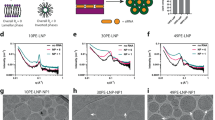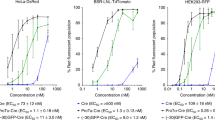Abstract
A detergent dialysis procedure is described which allows encapsulation of plasmid DNA within a lipid envelope, where the resulting particle is stabilized in aqueous media by the presence of a poly(ethyleneglycol) (PEG) coating. These ‘stabilized plasmid-lipid particles’ (SPLP) exhibit an average size of 70 nm in diameter, contain one plasmid per particle and fully protect the encapsulated plasmid from digestion by serum nucleases and E. coli DNase I. Encapsulation is a sensitive function of cationic lipid content, with maximum entrapment observed at dioleoyldimethylammonium chloride (DODAC) contents of 5 to 10 mol%. The formulation process results in plasmid-trapping efficiencies of up to 70% and permits inclusion of ‘fusigenic’ lipids such as dioleoylphosphatidylethanolamine (DOPE). The in vitro transfection capabilities of SPLP are demonstrated to be strongly dependent on the length of the acyl chain contained in the ceramide group used to anchor the PEG polymer to the surface of the SPLP. Shorter acyl chain lengths result in a PEG coating which can dissociate from the SPLP surface, transforming the SPLP from a stable particle to a transfection-competent entity. It is suggested that SPLP may have utility as systemic gene delivery systems for gene therapy protocols.
This is a preview of subscription content, access via your institution
Access options
Subscribe to this journal
Receive 12 print issues and online access
$259.00 per year
only $21.58 per issue
Buy this article
- Purchase on Springer Link
- Instant access to full article PDF
Prices may be subject to local taxes which are calculated during checkout








Similar content being viewed by others
References
Huang L, Li S . Liposomal gene delivery: a complex package Nature Biotech 1997 15: 620–621
Templeton NS et al. Improved DNA:liposome complexes for increased systemic delivery and gene expression Nature Biotech 1997 15: 647–652
Hofland HJ et al. In vivo gene transfer by intravenous administration of stable cationic lipid/DNA complex Pharmaceut Res 1997 14: 742–749
Thierry AR et al. Systemic gene therapy: biodistribution and long-term expression of a transgene in mice Proc Natl Acad Sci USA 1995 92: 9742–9746
Harrison GS et al. Optimization of gene transfer using cationic lipids in cell lines and primary human CD4+ and CD34+ hematopoietic cells Biotechniques 1995 19: 816–823
Li S, Huang L . In vivo gene transfer via intravenous administration of cationic lipid-protamine-DNA (LPD) complexes Gene Therapy 1997 4: 891–900
Profitt RT et al. Liposomal blockade of the reticuloendothelial system: improved tumor imaging with small unilamellar vesicles Science 1983 220: 502–505
Gabizon A, Papahadjopoulos D . Liposome formulations with prolonged circulation time in blood and enhanced uptake by tumors Proc Natl Acad Sci USA 1988 85: 6949–6953
Chonn A, Cullis PR . Recent advances in liposome drug delivery systems Curr Opin Biotech 1995 6: 698–708
Kohn S, Nagy JA, Dvorak HF, Dvorak AM . Pathways of macromolecular tracer transport across venules and small veins. Structural basis for the hyperpermeability of tumor blood vessels Lab Invet 1992 67: 596–607
Reimer DL et al. Formation of novel hydrophobic complexes between cationic lipids and plasmid DNA Biochemistry 1995 34: 12877–12883
Harasym TO et al. Poly(ethyleneglycol)-modified phospholipids prevent aggregation during covalent conjugation of proteins to liposomes Bioconj Chem 1995 6: 187–194
Holland JW, Hui C, Cullis PR, Madden TD . Poly(ethyleneglycol)-lipid conjugates regulate the calcium-induced fusion of liposomes composed of phosphatidylethanolamine and phosphatidylserine Biochemistry 1996 35: 2618–2624
Xu Y, Szoka FC . Mechanism of DNA release from cationic liposome/DNA complexes used in cell transfection Biochemistry 1996 35: 5616–5623
Farhood H, Serbina N, Huang L . The role of dioleoylphosphatidylethanolamine in cationic liposome mediated gene transfer Biochim Biophys Acta 1995 1235: 289–295
Chonn A, Semple SC, Cullis PR . Association of blood proteins with large unilamellar liposomes in vivo. Relation to circulation lifetimes J Biol Chem 1992 267: 18759–18765
Mimms LT et al. Phospholipid vesicle formation and transmembrane protein incorporation using octylglycoside Biochemistry 1981 20: 833–840
Fraley R, Subramani S, Berg P, Papahadjopoulos D . Introduction of liposome-encapsulated SV40 DNA into cells J Biol Chem 1980 255: 10431–10435
Soriano P et al. Targeted and nontargeted liposomes for in vivo transfer to rat liver cells of a plasmid containing the preproinsulin I gene Proc Natl Acad Sci USA 1983 80: 7128–7131
Nakanishi M et al. Efficient introduction of contents of liposomes into cells using HVJ (Sendai virus) Exp Cell Res 1985 159: 399–409
Fraley RT, Fornari CS, Kaplan S . Entrapment of a bacterial plasmid in phospholipid vesicles: potential for gene therapy Proc Natl Acad Sci USA 1979 76: 3348–3352
Nicolau C, Rottem S . Expression of a β-lactamase activity in Mycoplasma carpicolum transfected with the liposome-encapsulated E. coli pBR32 plasmid Biochem Biophys Res Commun 1982 108: 982–986
Stavridis JC et al. Construction of transferrin-coated liposomes for in vivo transport of exogenous DNA to bone marrow erythroblasts in rabbits Exp Cell Res 1986 164: 568–572
Wang C-Y, Huang L . pH-sensitive immunoliposomes mediate target cell-specific delivery and controlled expression of a foreign gene in mouse Proc Natl Acad Sci USA 1987 84: 7851–7855.
Lurquin PF . Entrapment of plasmid DNA by liposomes and their interactions with plant protoplasts Nucleic Acids Res 1979 6: 3773–3784
Alino SF et al. In vivo delivery of human alpha 1-antitrypsin gene to mouse hepatocytes by liposomes Biochem Biophys Res Commun 1993 192: 174–181
Baru M, Axelrod JH, Nur I . Liposome-encapsulated DNA-mediated gene transfer and synthesis of human factor IX in mice Gene 1995 161: 143–150
Jay DG, Gilbert W . Basic protein enhances the incorporation of DNA into lipid vesicles: model for the formation of primordial cells Proc Natl Acad Sci USA 1987 84: 1978–1980
Puyal C, Milhaud P, Bienvenue A, Philippot JR . A new cationic liposome encapsulating genetic material. A potential delivery system for polynucleotides Eur J Biochem 1995 228: 697–703
Ibanez M et al. Spermidine-condensed DNA and cone-shaped lipids improve delivery and expression of exogenous DNA transfer by liposomes Biochem Cell Biol 1997 74: 633–643
Ausubel F et al (eds). Preparation and analysis of DNA. In: Short Protocols in Molecular Biology, 3rd edn John Wiley: New York, 1995, ppA1–A58
King GI, Jacobs RE, White SH . Hexane dissolved in dioleoyllecithin bilayers has a partial molar volume of approximately zero Biochem J 1985 24: 4637–4645
Ollivon M, Eidelman O, Blumenthal R, Walter A . Micelle-vesicle transition of egg phosphatidylcholine and octylglucoside Biochem J 1988 27: 1695–1703
Vinson PK, Talmon Y, Walter A . Vesicle-micelle transition of phosphatidylcholine and octylglucoside elucidated by cryo-transmission electron microscopy Biophys J 1989 56: 669–681
Cullis PR, de Kruijff B . The polymorphic phase behaviour of phosphatidylethanolamines of natural and synthetic origin Biochim Biophys Acta 1978 513: 31–42
Holland JW, Cullis PR, Madden TD . Poly(ethyleneglycol)-lipid conjugates promote bilayer formation in mixtures of non-bilayer forming lipids Biochemistry 1996 35: 2610–2617
Webb MS et al. Comparison of different hydrophobic anchors conjugated to poly(ethyleneglycol): effects on the pharmacokinetics of liposomal vincristine (submitted)
Birnboim HC, Doly J . A rapid alkaline extraction procedure for screening recombinant plasmid DNA Nucleic Acids Res 1979 7: 1513–1522
Sambrook J, Fritsch EF, Maniatis T . Extraction and purification of plasmid DNA. In: Ford N, Nolan C, Ferguson M (eds) . Molecular Cloning, 2nd edn Cold Spring Harbor Laboratory Press: New York 1989 1.38–1.39
Hope MJ, Bally MB, Webb G, Cullis PR . Production of large unilamellar vesicles by a rapid extrusion procedure: characterization of size, trapped volume and ability to maintain a membrane potential Biochim Biophys Acta 1985 812: 55–65
Cudd A, Nicolau C . Intracellular fate of liposome-encapsulated DNA in mouse liver. Analysis using electron microscope autoradiography and subcellular fractionation Biochim Biophys Acta 1985 845: 477–491
Szelei J, Duda E . Entrapment of high molecular mass DNA molecules in liposomes for the genetic transformation of animal cells Biochem J 1989 259: 549–553
Monnard P-A, Oberholzer T, Luisi P . Entrapment of nucleic acids in liposomes Biochim Biophy Acta 1997 1329: 39–50
Author information
Authors and Affiliations
Rights and permissions
About this article
Cite this article
Wheeler, J., Palmer, L., Ossanlou, M. et al. Stabilized plasmid-lipid particles: construction and characterization. Gene Ther 6, 271–281 (1999). https://doi.org/10.1038/sj.gt.3300821
Received:
Accepted:
Published:
Issue Date:
DOI: https://doi.org/10.1038/sj.gt.3300821
Keywords
This article is cited by
-
Structure and Function of Cationic and Ionizable Lipids for Nucleic Acid Delivery
Pharmaceutical Research (2023)
-
A novel method for the development of plasmid DNA-loaded nanoliposomes for cancer gene therapy
Drug Delivery and Translational Research (2022)
-
Polyethylene glycol–modified DOTAP:cholesterol/adenovirus hybrid vectors have improved transduction efficiency and reduced immunogenicity
Journal of Nanoparticle Research (2021)
-
Exploring the HYDRAtion method for loading siRNA on liposomes: the interplay between stability and biological activity in human undiluted ascites fluid
Drug Delivery and Translational Research (2017)
-
Non-viral vectors for gene-based therapy
Nature Reviews Genetics (2014)



